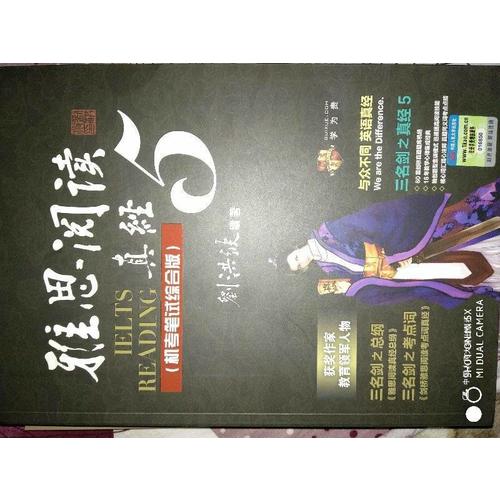本書的改版根據雅思考試動態,融合機考信息,覆蓋劍12。《雅思閱讀真經5(機考筆試綜合版版)》全書包括7章和5個附錄。書中的原文與真實的雅思考試如出一轍,原文所涉及的范疇涵蓋近幾年完整的閱讀真題題庫。在此基礎上,分成7個題型進行有效訓練。通過這7種題型的訓練,可以熟悉題型特點,印證《雅思閱讀真經總綱》中的做題方法,掌握“考點詞”,從而達到基礎與技巧同時提高、素材與考點同步熟悉的訓練目的。書中每篇文章均采用不同的排版方式,力求與雅思真題的呈現模式一致。
書中的附錄亦為考生須知。若考生仍有疑問,可按書中所給答疑方式進行咨詢。
無論你基礎如何,無論你何時考試,《雅思閱讀真經5》都是必讀的。若基礎薄弱,請看《劍橋雅思閱讀考點詞真經》,若方法迷茫,請看《雅思閱讀真經總綱》。三劍合璧,天下無敵!
本書適合所有參加雅思考試的學生,在雅思備考的每一個階段都是適用的。中國雅思考試官方英國文化處(British Council)認證名師經典作品。《雅思閱讀真經5》自出版之日起,一直到今天都是整個培訓領域真題命中率高的一本閱讀書,代表了整個雅思培訓行業對于真題教學研究的高水平,代表了測試和訓練的契合方式。從2004年到現在,不論怎樣去還原真題,真經永遠代表貼近出題原理,而且無可替代的一個品牌。這本書提供給你的不僅僅是真題還原,而是完整的訓練方式。通過選擇有針對性的訓練材料進行分項測試,讓考生的閱讀能力有實質性飛躍。是的,這就是強悍的真經,可以跟任何一種教學理論相結合的真經,讓所有雅思考生感到信賴和驕傲的真經。
劉洪波,學為貴教育創始人,獲獎作家,教育領軍人物,北京雅思總校校長。年少沉醉于水墨書法,道經音律;后負笈海外,喜兩希文化,研習拉丁。歸國后投身英語教育事業,培養出大批雅思、托福、四六級、考研英語名師。連續數年赴西部支教,共培訓上千名初高中英語教師。
著有《英文字根詞源真經》《雅思閱讀真經5》《劍橋雅思閱讀考點詞真經》《劍橋雅思聽力考點詞真經》《雅思寫作真經總綱》《托福閱讀考點詞真經》等數十部作品。其留學散文被《海外文摘》《青年文摘》等眾多媒體登載,廣為流傳,2013年將其在澳大利亞留學的傳奇經歷集結成集,出版了《留學SUPER之路》。其2004年出版的《雅思閱讀真經》是國內及時本以真題題庫為藍本編寫的培訓教材,考試命中率極高,暢銷海內外,開創了真題機經的教材流派。2007年被各大教育媒體譽為“雅思教父”;2009年當選“建國60年推動中國教育培訓發展功勛人物”;入選網易年度 “教育產業十大領軍人物”。多次應邀赴劍橋、牛津等名校進行英語教學培訓交流研討。在全國高校巡回演講數百場,聽過其講座和課程的學員不可勝數。學員點評其授課風格為:行云流水,旁征博引,激情四射,勵志人生。
Introduction 介紹
CHAPTER 1 Summary 單詞填寫題
Reading Passage 1 The Refrigerator
Reading Passage 2 Alfred Nobel
Reading Passage 3 Lost Giant: Mammoth
Reading Passage 4 Tasmanian Tigers
Reading Passage 5 The Lost Continent
Reading Passage 6 Clarence Saunders
Reading Passage 7 Fraud in Science
Reading Passage 8 Graffiti: Street Art or Crime
Reading Passage 9 Ancient Money
Reading Passage 10 Talc Powder
Reading Passage 11 Soviet’s New Working Week
Reading Passage 12 Spectacular Saturn
Reading Passage 13 Thomas Young
CHAPTER 2 True/False/Not Given 句子理解判斷題
Reading Passage 14 Yawn
Reading Passage 15 A Brief History of Chocolate
Reading Passage 16 Morse Code
Reading Passage 17 Torch Relay
Reading Passage 18 The Voynich Manuscript
Reading Passage 19 Bondi Beach
Reading Passage 20 The Dutch Tulip Mania
Reading Passage 21 The Benefits of Bamboo
Reading Passage 22 Chinese Yellow Citrus Ant for Biological Control
Reading Passage 23 Animal Self-medication
Reading Passage 24 Rapid, Urban and Flexible
Reading Passage 25 Self-esteem Myth
Reading Passage 26 William Gilbert and Magnetism
CHAPTER 3 Paragraph Heading 段落中心思想題
Reading Passage 27 Pearls
Reading Passage 28 Temperaments and Communication Styles
Reading Passage 29 E-book
Reading Passage 30 Self-marketing
Reading Passage 31 Maps and Atlas
Reading Passage 32 Dyes and Pigments
Reading Passage 33 TV Addiction
Reading Passage 34 Medieval Toys and Childhood
CHAPTER 4 Matching 信息匹配題
Reading Passage 35 Orientation of Birds
Reading Passage 36 Liar Detector
Reading Passage 37 Left-handed
Reading Passage 38 Choice and Happiness
Reading Passage 39 The Father of Modern Management
Reading Passage 40 Ambergris
Reading Passage 41 Interpretation
Reading Passage 42 Barristers and Solicitors
Reading Passage 43 An Exploration of Alchemy
Reading Passage 44 Isambard Kingdom Brunel
Reading Passage 45 Artist Fingerprints
Reading Passage 46 Mental Gymnastics
CHAPTER 5 Multiple Choice 選擇題
Reading Passage 47 Koala
Reading Passage 48 Violin Making
Reading Passage 49 El Niño
Reading Passage 50 Booming Bittern
CHAPTER 6 Diagram 圖表題
Reading Passage 51 Jethro Tull and Seed Drill
Reading Passage 52 The Oceanographer’s Dream Ship
Reading Passage 53 Travelers’ Accounts
Reading Passage 54 Perfume
Reading Passage 55 From Novices to Experts
Reading Passage 56 Two Wings and a Kit-box
CHAPTER 7 Real Test 真題模考
Test 1
Test 2
APPENDIX 附錄
附錄1 Answer Keys 答案
附錄2 2004—2014 真題一覽表
附錄3 答疑錄
附錄4 劍橋大學雅思訪問記
附錄5 口碑推薦:“絕世好書”《雅思寫作真經總綱》
Reading Passage 1
The Refrigerator
Many of the conveniences we enjoy in our homes are the result of years of innovation by dedicated inventors. Though we take many of them for granted, some—like the refrigerator— have hugely affected the way we live our lives. Who invented the refrigerator, and how has it evolved over time?
Early Refrigeration
Preserving food has not always been easy. Centuries ago, people gathered ice from streams and ponds and did their best to store it year-round in icehouses and cellars, so they had a ready supply to keep their food cold. Even with ice, people were often limited to eating locally grown foods that had to be purchased fresh and used daily. The Egyptians, Chinese and Indians were some of the early people to use ice in food preservation. In 1626, Sir Francis Bacon was also testing the idea that cold could be used to preserve meat; his chilly experiment caused him to develop pneumonia, from which he died on Easter Day, April 9, 1626.
Even Peter Mark Roget, compiler of Roget’s Thesaurus, studied refrigeration, suggesting a design for a “frigidarium.” Progress took time, however, and snow and ice served as the primary means of refrigeration until the beginning of the 20th century.
Iceboxes
According to the Association of Home Appliance Manufacturers, one of the next steps between storing ice underground and modern refrigeration was the icebox. Introduced in 19th century England, wooden iceboxes were lined with tin or zinc, and filled with sawdust, seaweed and other materials to keep the ice from melting. Drip pans caught the water that melted and had to be emptied daily.
In the United States, warm winters in 1889 and 1890 caused ice shortages that fueled the need to create a better refrigeration system. An Encyclopedia Britannica entry attributes the beginning of commercial refrigeration to Alexander C. Twinning, an American businessman, in 1856. Later, an Australian named James Harrison reviewed the refrigerator used by Twinning, and another made by physician John Gorrie, and developed vapor-compression refrigeration for the brewing and meatpacking industries.
In 1859, France’s Ferdinand Carré created a more advanced system that used ammonia as a coolant; the earlier vapor-compression machines used air. The ammonia worked well, but was toxic if it leaked. Engineers worked until the 1920s to come up with better alternatives, one of which was Freon.
書沒有封皮,送來的時候比較臟了而且封面有很多劃痕,但是應該是正版吧畢竟當當自營內容還是挺好的
和描述的一樣
自我感覺還不錯
真經不是真題……
真的很實用
書皮背壓到了
書不錯哦買的第二本啦
閱讀真經5也太不厚道了,買了書后,做著題到句子理解判斷題后看解析,每看一篇解析都需要付費!也太不人性化了,變相賺錢這是,哪有這樣子操作的。
不錯很好。
內容不錯 又買了兩本
就是沒好好做真經5,7就差一點,有空好好看看!
據說比雅思真題要簡單,作為真經的配合書,看完那些技巧之后來做這本,掌握技巧后再去做真題。
 書很厚實,題型涵蓋全面。印刷清晰,紙質挺厚的。最新版的更新了一些題目。
書很厚實,題型涵蓋全面。印刷清晰,紙質挺厚的。最新版的更新了一些題目。